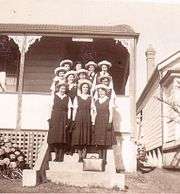School uniform
| |||||||
A school uniform is a uniform worn by students primarily for a school or otherwise educational institution. They are common in primary and secondary schools in various countries. Although often used interchangeably, there is an important distinction between dress codes and school uniforms: according to scholars such as Nathan Joseph, clothing can only be considered a uniform when it "(a) serves as a group emblem, (b) certifies an institution's legitimacy by revealing individual’s relative positions and (c) suppresses individuality."[1] An example of a uniform would be requiring white button-downs and ties for boys and pleated skirts for girls, with both wearing blazers. A uniform can even be as simple as requiring collared shirts, or restricting colour choices and limiting items students are allowed to wear. A dress code, on the other hand, is much less restrictive, and focuses "on promoting modesty and discouraging anti-social fashion statements," according to Marian Wilde.[2] Examples of a dress code would be not allowing ripped clothing, no logos or limiting the amount of skin that can be shown.
History
It is difficult to trace the origins of the uniform as there is no comprehensive written history but rather a variety of known influences. Although uniforms can often be considered conservative and old-fashioned, uniforms in recent years have changed as societal dress codes have changed.[3] Little is known prior to the Archbishop of Canterbury ordered monks to wear a specific monastic form of dress. Despite this example, the roots of the modern day uniform come mostly from the collegiate uniforms in England. Universities, primary schools and secondary schools used uniforms as a marker of class and status, which in turn served as a boundary.[4] As early as the sixteenth century, uniforms were utilised and became more specific as various fashion trends became undesirable to the university.
Contemporary


In the United States, a movement toward using uniforms in state schools began when Bill Clinton addressed it in the 1996 State of the Union, saying: "If it means that teenagers will stop killing each other over designer jackets, then our public schools should be able to require their students to wear uniforms."[5] As of 1998 approximately 25% of all U.S. public elementary, middle and junior high schools had adopted a uniform policy or were considering a policy, and two thirds were implemented between 1995 and 1997.[6]
There are an abundance of theories and empirical studies looking at school uniforms, making statements about their effectiveness. These theories and studies elaborate on the benefits and also the shortcomings of uniform policies. The issue of nature vs. nurture comes into play, as uniforms affect the perceptions of masculinity and femininity, complicate the issue of gender classification and also subdue the sexuality of girls. With uniforms also comes a variety of controversies, pros, cons and major legal implications.
There are two main empirical findings that are most often cited in the political rhetoric surrounding the uniform debate. One of these, the case study of the Long Beach Unified School District, is most often cited in support of school uniforms and their effectiveness whereas Effects of Student Uniforms on Attendance, Behavior Problems, Substance Use, and Academic Achievement is the most frequently cited research in opposition to the implementation of school uniform policies.
Long Beach Unified School District study
The case study of the Long Beach Unified School District was the study of the first large, urban school in the United States to implement a uniform policy. In 1994, mandatory school uniforms were implemented for the districts elementary and middle schools as a strategy to address the students' behaviour issues.[7] The district simultaneously implemented a longitudinal study to research the effects of the uniforms on student behavior. The study attributed favourable student behavioral changes and a significant drop in school discipline issues[7] to the mandatory uniform policy. This case study attributed the following noticeable outcomes to the use of uniforms throughout the district:
- Fewer absences and truancies;
- Fewer referrals to the office for behavior problems;
- Fewer suspensions and expulsions;
- Reduced by 28% (elementary) and 36% (middle school);
- Decreased crime and vandalism;
- Reduced by 74% (elementary) and 18% (middle school);
- Better grades, and in some cases, significantly higher achievement.[8]
Effects of uniforms on students

Research, on the other hand, empirically examined how a school uniform affects attendance, behavior problems, substance abuse, and academic achievement. In this very well known study, researchers tested the following hypotheses:
- Student uniforms decrease substance use;
- Student uniforms decrease behavioural problems;
- Student uniforms increase attendance;
- Student uniforms increase academic achievement.
Researchers in this study expected that the direct of uniforms on these outcomes would disappear once the moderating variables were introduced to the equation. If this were to be the case, then arguments proclaiming uniform policies' direct effect on said outcomes would be proven false. This study used a nationally representative sample of students. From the results, researchers were able to conclude that students wearing uniforms did not have any significant difference in academic preparedness or proschool attitudes than other students. Researchers also found that student uniforms were not significantly correlated with school commitment variables such as truancy, behaviour, or drug abuse. In terms of the original four hypotheses researchers found that:
- Student uniforms were not an effective deterrent to decrease truancy;
- Student uniforms did not decrease behavior problems;
- Student uniforms did not decrease substance use;
- Student uniforms did not increase student achievement.
Because the four hypotheses were not supported, researchers were able to conclude that implementing uniform policies at high school level does not create the desired outcomes, as all four of the original hypotheses were derived from public discourse surrounding the uniform debate. In fact, Brunsma et al., 1998 found that uniforms had a significant negative effect on achievement, as students who wore uniforms and had high proschool attitudes actually had worse behavior problems than all other students. Researchers in this study suggested that "instead of directly affecting specific outcomes, uniforms act as a catalyst for change and provide a highly visible opportunity for additional programs" within schools. In fact, Brunsma et al., 1998 found that this was the case with the Long Beach Unified School District case study, as several additional reform efforts were implemented simultaneously with the mandatory uniform policy.[8]
Laws and rulings

As uniforms have become more normalised, there have also been an increasing number of lawsuits brought against school districts. According to David Brunsma, one in four public elementary schools and one in eight public middle and high schools in the USA have policies dictating what a student wears to school.[9] The school code within states’ constitutions typically asserts that it allows the board of school directors to make reasonable rules and regulations as they see fit in managing the school’s affairs. As of 2008, there are currently 23 states that allow school districts to mandate school uniforms.[10] The constitutional objections usually brought upon school districts tend to fall into one of the following two categories: (1) a violation of the students’ First Amendment right to free expression (2) a violation of parents' right to raise their children without government interference. Although up until this point, The Supreme Court has not ruled on a case involving school uniforms directly, in the 1968 Tinker v. Des Moines Independent Community School District, the Court ruled that upon entering school, students do not shed their constitutional rights to freedom of speech.[11]
Internationally, there are differing views of school uniforms. In the Australian state of Queensland, Ombudsman Fred Albietz ruled in 1998 that state schools may not require uniforms.[12] In the Philippines, the Department of Education abolished the requirement of school uniforms in public schools.[13] In England and Wales, technically a state school may not permanently exclude students for "breaching school uniform policy", under a policy promulgated by the Department for Children, Schools and Families but students not wearing the correct uniform are asked to go home and change. In Scotland, some local councils (that have responsibility for delivering state education) do not insist on students wearing a uniform as a precondition to attending and taking part in curricular activities.[14] Turkey abolished mandatory uniforms in 2010.[15]
Examples of lawsuits in the United States
Canady v. Bossier Parish School Board
In the Canady v. Bossier Parish School Board lawsuit in 2000, a Louisiana district court ruled in favour of the school board because it did not see how the free speech rights of the students were being violated due to the school board's uniform policy. Even though the plaintiff appealed the decision, the Fifth Circuit Court also ruled in favour of the school board after implementing a four-step system that is still used today. Firstly, a school board has to have the right to set up a policy. Secondly, the policy must be determined to support a fundamental interest of the board as a whole. Thirdly, the guidelines cannot have been set for the purpose of censorship. Finally, the limits on student expression cannot be greater than the interest of the board. As long as these four policies are in place, then no constitutional violation can be claimed.[16]
Littlefield v. Forney Independent School District
In the Forney Independent School District of Forney, Texas in 2001, the school board decided to implement a school uniform policy allowing the students to wear a polo shirt, oxford shirt or blouse in four possible colours, and blue or khaki pants or shirts, a skirt or jumper. While there was some flexibility with shoes, certain types were prohibited along with any sort of baggy clothes. The parents of the Littlefield family requested that their son be exempt from the policy, but were denied. In response, the Littlefields filed a lawsuit against the school district, under the pretenses that this uniform mandate infringed on their rights as parents to control how they brought up their children and their education. They even went as far as to cite an infringement on religious freedom, claiming that opting out of the uniforms on the grounds of religion allowed the school to rank the validity of certain religions. Before trial, the District Court dismissed the case, so the family appealed. Ultimately, the Fifth Circuit Court ruled that the students' rights were not being violated even though the claims presented were valid. They ruled that school rules derived from the education would override the parents' right to control their children's upbringing in this specific situation. As far as the religious freedom violation accusations, the court ruled that the policy did not have a religious goal, and thus did not infringe on religious freedom rights.[17]
Jacobs v. Clark County School District
In 2003, Liberty High School, a school of the Clark County School District in Henderson, Nevada, implemented a uniform policy of khakis and red, white or blue polo shirts. A junior by the name of Kimberly Jacobs was suspended a total of five times because she wore a religious shirt to school and got cited for uniform violations. Her family sued the Clark County School District under the claims that her First Amendment rights were being infringed upon and that the uniform policy was causing students to be deprived of due process. The plaintiff's requests were for injunctive relief, the expunging of suspensions from Jacob's school record and awarding of damages. The injunction was granted to the family meaning that the school could no longer discipline her for breaking the uniform policy. At this ruling, the school district appealed. The next court ruled on the side of the school district as it determined that the uniform policy was in fact neutral and constitutional, and it dismissed the claims of the plaintiff.[18]
Frudden v. Washoe County School District
In 2011, a Nevada public elementary school of the Washoe County School District decided to add the school's motto, Tomorrow's Leaders embroidered in small letters on the shirt. In response, Mary and John Frudden, parents of a student sued the school district on the basis of it violating the 1st Amendment. The court ultimately dismissed the case filed by the Fruddens over the uniforms. However, the family appealed, and two years later, a three-judge panel of the 9th U.S. Circuit Court of Appeals heard the case. The court ruled to reverse the previous decision of dismissing the case, and also questioned the apparent policy for students that were part of a nationally recognised group such as Boy Scouts and Girl Scouts who were able to wear the uniforms in place of the school ones on regular meeting days. The 9th circuit panel ruled that the school had not provided enough evidence for why it instituted this policy, and that the family was never given a chance to argue.[19]
Social implications of school uniforms on gender
There are several positive and negative social implications of uniforms on both the students wearing them and society as a whole.
Perceptions of masculinity and femininity


One of the criticisms of uniforms is that it imposes standards of masculinity and femininity from a young age. Uniforms are considered a form of discipline that schools use to control student behavior and often promote conventional gendered dress.[20][21] Boys often are required to wear trousers, belts, and closed-toe shoes and have their shirts tucked in at all times. They are also often required to have their hair cut short. Some critics allege that this uniform is associated with the dress of a professional business man, which, they claim, gives boys at a young age the impression that masculinity is gained through business success.[22] For girls, some uniforms promote femininity by requiring girls to wear skirts. Skirts are seen by some critics as a symbol of femininity because they restrict movement and force certain ways of sitting and playing.[21]
Sexualization of girls
Uniforms often start to increase in popularity around middle school in the United States, when students begin going through puberty. Uniforms can be seen as a way to restrict the sexualization of girls (rules on hems of skirts, no shoulders). Uniforms take the focus away from sexuality and focus it on academics in a school setting for girls.[23]
Miniskirts have been very popular in Japan, where they became part of school uniforms, and they came to be worn within the Kogal culture.[24][25]
Controversies
General

In some cultures, the topic of school uniforms has sparked a multitude of controversies and debates over the years. Debates concerning the constitutionality and economic feasibility of uniforms also contribute to the controversy.
In the United States, the implementation of school uniforms began following ten years of research indicating the effectiveness of private schools. Some state-school reformers cited this research to support policies linked to private and Catholic school success. However, within the Catholic school literature, school uniforms have never been acknowledged as a primary factor in producing a Catholic school effect.[26][27] Some public-school administrators began implementing uniform policies to improve the overall school environment and academic achievement of the students. This is based on the assumption that uniforms are the direct cause of behavioral and academic outcome changes.[27]
Another area of controversy regarding school uniform and dress code policies revolve around the issue of gender. Nowadays, more teenagers are more frequently "dressing to articulate, or confound gender identity and sexual orientation", which brings about "responses from school officials that ranged from indifferences to applause to bans".[28] In 2009, there were multiple conflicts across the United States arising from disparities between the students' perception of their own gender, and the school administrators' perception of the students' gender identity. Instances include the following:[29]
- Spring 2009: Marion County, FL – Students must dress "in keeping with their gender"
- Boy came to school wearing high-heeled boots, a stuffed bra, and a V-neck T-shirt, he was sent home to change because he was "cross-dressing"
- May 2009: gay male student at LA high school was crowned prom queen
- Aug 2009: Mississippi senior female barred from yearbook because she had posed in a tuxedo
- Sept 2009: Tucson, AZ a freshman trans boy was nominated for homecoming prince
- Oct 2009: Cobb County, GA sent home a boy who favored wigs, makeup, and skinny jeans
- Nov 2009: Cross-dressing Houston senior was sent home because his wig violated the school's dress code rule that a boy's hair may not be "longer than the bottom of a regular shirt collar"
Although not all schools in the United States are required to wear school uniforms, the United States is slowly adapting the use of school uniforms. "Almost one in five US public schools required students to wear uniforms during the 2011-2012 school year, up from one in eight in 2003-2004."[30] The ideology of school uniform is that it will create a safer environment for students and help with equality. In some areas uniforms have become essential due to the poverty level that the schools reside in. "Mandatory uniform policies in public schools are found more commonly in high-poverty areas."[31]
Positives


Advocates of uniforms have proposed multiple reasons supporting their implementation and claiming their success in schools. A variety of these claims have no research supporting them. Some of these pros include the following: Advocates believe that uniforms affect student safety by:[8]
- Lowering student victimization
- Decrease gang activity and fights[32]
- Differentiating strangers from students in school buildings
For example, in the first year of the mandatory uniform policy in Long Beach, California, officials reported that fighting in schools decreased by more than 50%, assault and battery by 34%, sex offenses by 74%, and robbery by 66%.[32] Advocates also believe that uniforms increase student learning and positive attitudes toward school through:
- Enhanced learning environments
- Heightened school pride
- Increased student achievement
- High levels of preparedness
- Conformity to organizational goals
- Increased chance of staying in school[33]
- Increased commitment to learning[33]
- Increased use of school setting to the student’s advantage[33]
Wearing uniforms leads to decreased behavior problems by increasing attendance rates, lowering suspension rates, and decreasing substance use among the student body. Proponents also attribute positive psychological outcomes like increased self-esteem, increased spirit, and reinforced feelings of oneness among students to wearing uniforms. Additional proponent arguments include that school uniforms:[34]
- Encourage discipline
- Help students resist peer pressure to buy trendy clothes
- Diminish economic and social barriers between students
Currently pros of school uniforms center around how uniforms impact schools' environments. Proponents have found a significant positive impact on school climate, safety, and students’ self-perception from the implementation of uniforms.
Negatives
The opposing side of uniforms have claimed their ineffectiveness using a variety of justifications, a variety of which have research supporting them. Some of the cons to school uniforms include the following legal, financial, and questionable effectiveness concerns:[8] The primary concern with school uniforms or strict dress codes is that it limits the ability of the student to express themselves. Clothing is viewed as a mean of expression. By making all students wear the same clothes or limit them to what they can wear, can disrupt their sense of identity. One of the main controversies can lie within Dress Code Policies vs. Freedom of Speech.[35] This establishes that students cannot wear the latest trends, mid-drift, or clothes that the school finds that interrupts the learning environment. Although, students can wear clothing artifacts that express their religion. " Both the Constitution and most state laws protect students’ rights to wear religious attire inool school, such as the wearing of a turban, yarmulke, or head scarf."[35]
Another negative aspect of school uniforms is that it can be sexist. Boys and girls are not disciplined the same when it comes to dress codes. "Transgender students have been sent home for wearing clothing different from what’s expected of their legal sex, while others have been excluded from yearbooks."[36] Some schools are not advocates of females and females dressing of the opposite sex. Research on how school uniforms and school dress codes influence the student can be inconclusive, but many people oppose to school uniforms and strict dress code policies. "In the U.S., over half of public schools have a dress code, which frequently outline gender-specific policies."[36]
- Legal concerns
- Focus on the supposition that requiring a uniform violates children’s individual rights (Thomas, 1994; Virginia State Dep’t of Edu, 1992)
- Mandatory uniform policies are being considered largely for urban school districts, and, hence are being forced on a predominantly minority and poor student population (Thomas, 1994)
- Financial concerns
- Groups such as the American Civil Liberties Union have voiced concerns about the cost of uniforms, specifically that some disadvantaged parents are unable to afford them (Gursky, 1996)
- Questionable effectiveness of those policies
- Strongest opponents of uniform policies charge that no empirical evidence exists to support the numerous and varied claims of uniform proponents (LaPorte, Holoman, & Alleyne, 1992)
- School uniforms suppress students’ individuality by mandating standardization of appearance and removing student expression (Joseph, 1986[37])
- While uniform policies have been linked to school climate, safety, and student self-perception, there is no evidence to indicate that a uniform policy increases academic achievement (Wade & Stafford, 2003[38])
According to Marian Wilde,[39] additional opponent arguments include that school uniforms:
- Are simply a Band-Aid on the issue of school violence
- Make students a target for bullies from other schools
- Are an unfair additional expense for parents who pay taxes for a free public education
- Are difficult to enforce in public schools
See also
References
- ↑ Joseph, Nathan (1986). Uniforms and nonuniforms : communication through clothing. New York: Greenwood Press. ISBN 0313251959.
- ↑ Wilde, Marian. "Do Uniforms Make Schools Better". GreatSchools.net.
- ↑ Davidson, Alexander; Rae, John (19 February 1990). Blazers, Badges and Boaters: Pictorial History of School Uniform. Praeger. ISBN 0906619254.
- ↑ Brunsma, David L. (2004). The School Uniform Movement and What it Tells Us about American Education : a Symbolic Crusade. Lanham, Md. [u.a.]: ScarecrowEducation. p. 4. ISBN 157886125X.
- ↑ Boutelle, Marsha (2003). "UNIFORMS: Are They A Good Fit?". Educational Digest. 73 (6): 34–37.
- ↑ Wade, Kathleen; Stafford, Mary (August 2003). "Public School Uniforms: Effect on Perceptions of Gang Presence, School Climate, and Student Self-Perceptions". Education and Urban Society. 35 (4): 399–420.
- 1 2 Reed, Joshua B. "Effects of a School Uniform Policy on an Urban School District." Northern Michigan University. N.p., 1 August 2011. Web. 19 April 2015. <https://www.nmu.edu/sites/DrupalEducation/files/UserFiles/Files/Pre-Drupal/SiteSections/Students/GradPapers/Projects/Reed_Joshua_MP.pdf>.Wade, K. K., & Stafford, M. E. (2003). Public School Uniforms: Effect on Perceptions of Gang Presence, School Climate, and Student Self-Perceptions. Education and Urban Society, 35(4), 399–420. http://doi.org/10.1177/0013124503255002
- 1 2 3 4 Brunsma, David L., and Kerry A. Rockquemore. "Effects of Student Uniforms on Attendance, Behavior Problems, Substance Use, and Academic Achievement." The Journal of Educational Research 92.1 (1998): 53-62. Web. 31 March 2015. <https://faculty.unlv.edu/sloe/Courses/EPY%20702/Class%20Exercises/Lecture%201%20Materials/Articles/Brunsma%20et%20al.%20(1998).pdf>
- ↑ Brunsma, David L. Uniforms in Public Schools: A Decade of Research and Debate. Lanham: Rowman & Littlefield Education, 2006. Print.
- ↑ Colasanti, Michael. "School Uniforms and Dress Codes: State Policies." StateNote (2008). Education Commission of the States. Education Commission of the States. Web. 19 April 2015. <http://www.ecs.org/clearinghouse/77/97/7797.pdf>.
- ↑ Kraft, Jacquelyn. Society's Perceptions and Attitudes Toward School Uniforms. Research Paper. University of Wisconsin-Stout. August 2003. Web http://citeseerx.ist.psu.edu/viewdoc/download?doi=10.1.1.390.8124&rep=rep1&type=pdf.
- ↑ "Those disgusting School Uniforms (B)". Optionality Magazine. Retrieved 30 November 2007.
- ↑ DepEd Order No. 45, s. 2008.
- ↑ "Authority Strategic Statement of Inverclyde Education Service". Gourock High School. Archived from the original on 14 March 2010. Retrieved 28 September 2009.
- ↑ School uniform requirement to be abolished
- ↑ "First Amendment Schools: The Five Freedoms - Court Case." First Amendment Schools: The Five Freedoms - Court Case. First Amendment Schools. Web. 19 April 2015. <http://www.firstamendmentschools.org/freedoms/case.aspx?id=1690>.
- ↑ "First Amendment Schools: The Five Freedoms - Court Case." First Amendment Schools: The Five Freedoms - Court Case. First Amendment Schools. Web. 19 April 2015. <http://www.firstamendmentschools.org/freedoms/case.aspx?id=1693>
- ↑ "Jacobs v. Clark County School District." The Recorder. 12 May 2008. Web. 19 April 2015. <http://www.therecorder.com/id=1202421325288/Jacobs-v-Clark-County-School-District?slreturn=20150319150918>.
- ↑ "Appeals Court Revives Reno School Uniform Case." Elko Daily. Elko Daily Free Press, 16 February 2014. Web. 12 April 2015. <http://elkodaily.com/news/appeals-court-revives-reno-school-uniform-case/article_a8e75868-973c-11e3-8412-001a4bcf887a.html>.
- ↑ Connell, R. W. "Teaching the Boys: New Research on Masculinity, and Gender Strategies for Schools". Teachers College Record 98:2 (1996): 206-235. 31 March 2015.
- 1 2 Happel, Alison. "Ritualized girling: school uniforms and the compulsory performance of gender." Journal of Gender Studies 22:1 (2013): 92-96. 1 April 2015.
- ↑ Craik, J. (2007). "Uniforms Exposed: The Proliferation of Uniforms in Popular Culture as Markers of Change and Identity." Uniformierungen in Bewegung. Ed. Gabreile Mentges, Dagmar Neuland-Kitzerow, and Birgit Richard. Munster: Waxmann Verlag. 7-53.
- ↑ American Psychological Association, Task Force on the Sexualization of Girls. (2007). Report of the APA Task Force on the Sexualization of Girls. Washington, DC: American Psychological Association. Retrieved from www.apa.org/pi/wpo/sexualization.html
- ↑ Kogal back in fashion- report by Japan Times
- ↑ Japan's schoolgirls set the trend
- ↑ The Catholic school effect is the thought that certain elements in a catholic school provide children with a stronger academic education
- 1 2 Brunsma, David L.; Rockquemore, Kerry A. "Effects of Student Uniforms on Attendance, Behavior Problems, Substance Use, and Academic Achievement." The Journal of Educational Research 92.1 (1998): 53-62. 31 March 2015.
- ↑ Hoffman, Jan (6 November 2009). "Can a Boy Wear a Skirt to School?" The New York Times.
- ↑ Hoffman, J. (8 November 2009). "Can a Boy Wear a Skirt to School?" The New York Times.
- ↑ "School Uniforms - ProCon.org". school-uniforms.procon.org. Retrieved 26 February 2016.
- ↑ "School Uniforms - ProCon.org". school-uniforms.procon.org. Retrieved 26 February 2016.
- 1 2 Wade, K. K., & Stafford, M. E. (2003). Public School Uniforms: Effect on Perceptions of Gang Presence, School Climate, and Student Self-Perceptions. Education and Urban Society, 35(4), 399–420. http://doi.org/10.1177/0013124503255002
- 1 2 3 Murray, R. K. (1997). The Impact of School Uniforms on School Climate. NASSP Bulletin, 81(593), 106–112. http://doi.org/10.1177/019263659708159314
- ↑ Wilde, Marian. The Debate Over Dress Codes and Uniforms (2006): 1-3.Boward Teacher's Union. July 2006. Web. 9 Apr 201
- 1 2 "School Dress Codes - FindLaw". Findlaw. Retrieved 26 February 2016.
- 1 2 Zhou, Li. "Why School Dress Codes Are Sexist". The Atlantic. Retrieved 26 February 2016.
- ↑ Joseph, Nathan. Uniforms and Nonuniforms: Communication through Clothing. Greenwood Press, New York, NY, 1986. ProQuest. Web. 18 April 2015.
- ↑ Wade, Kathleen Kiley, and Mary E. Stafford. "Public School Uniforms. Effect on Perceptions of Gang Presence, School Climate, and Student Self-Perceptions." Education and Urban Society 35.4 (2003): 399-420. ProQuest. Web. 18 April 2015.
- ↑ Wilde, Marian. The Debate Over Dress Codes and Uniforms (2006): 1-3.Boward Teacher's Union. July 2006. Web. 9 April 2015. <http://www.btuonline.com/pdfs/Education%20News%20PDFs/uniformdebate.pdf>.
External links
| Wikimedia Commons has media related to School uniform. |
- "School Uniforms." Ithaca College WISE: Working to Improve Schools and Education.
- Information and Resources: Public School Uniforms
- What's in a school uniform? BBC
- School Uniform: Japan at Boys' Historical Clothing






.jpg)